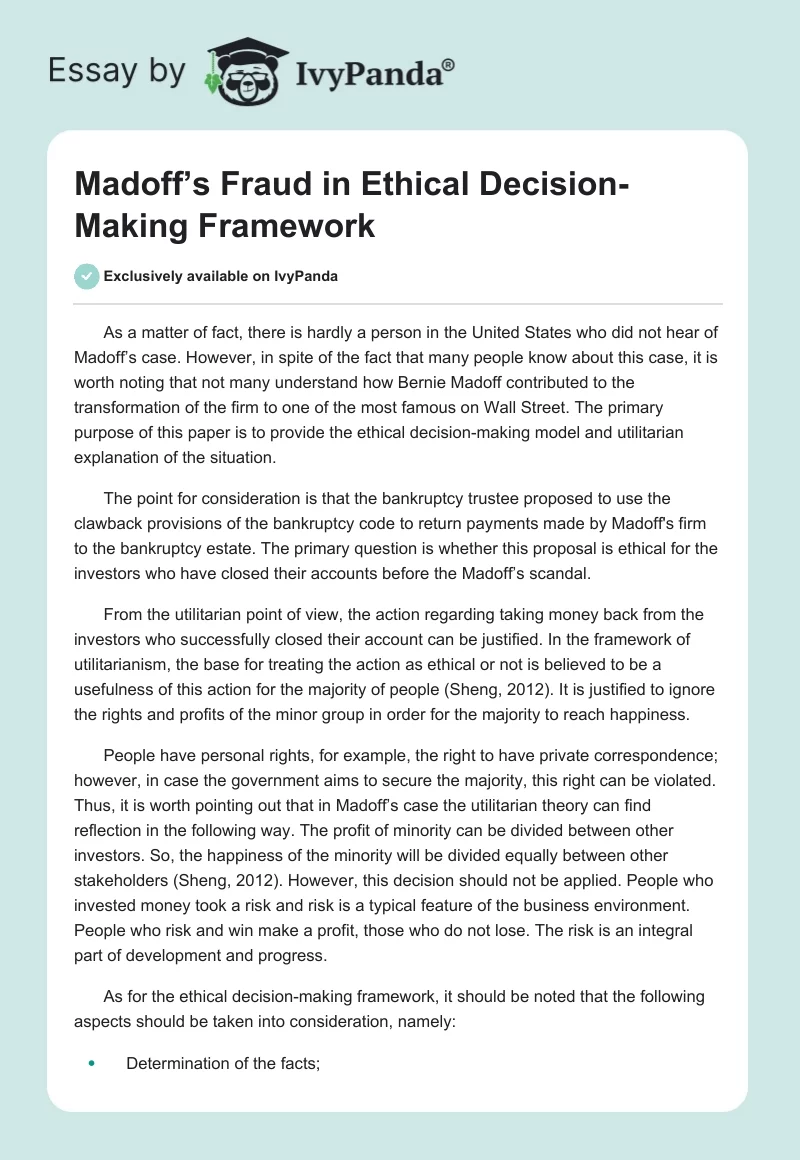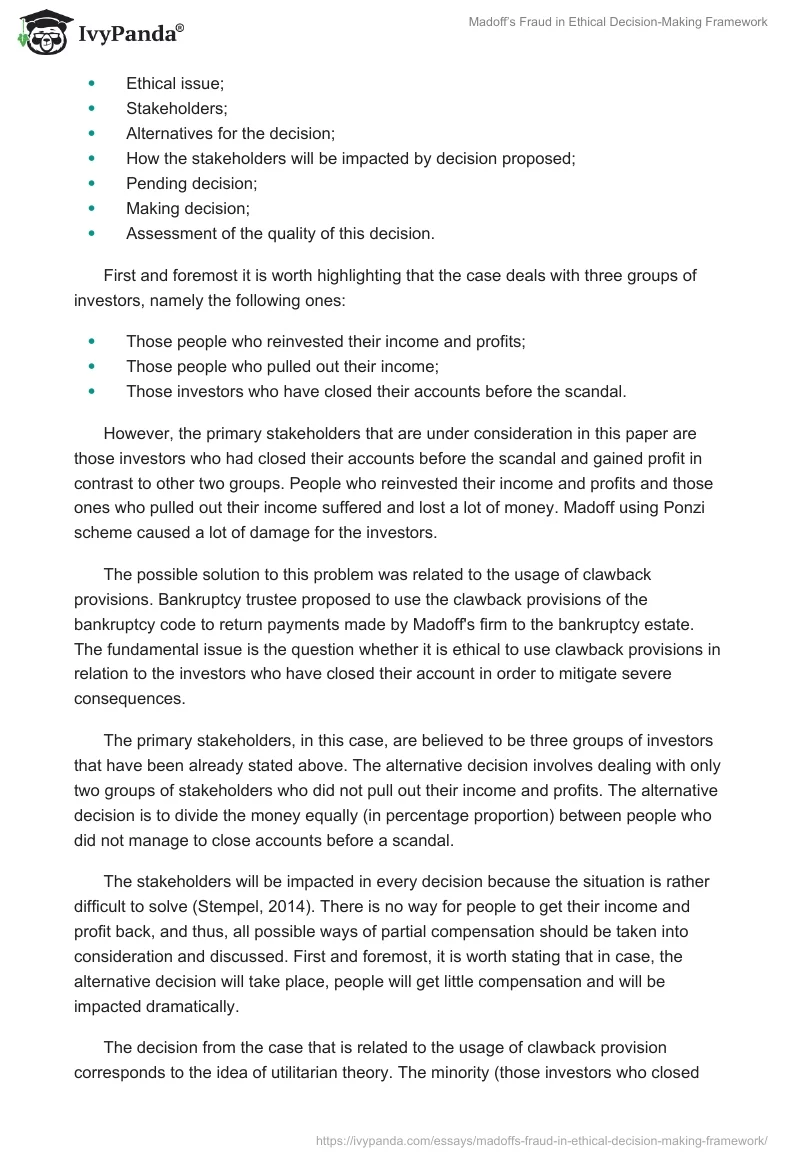As a matter of fact, there is hardly a person in the United States who did not hear of Madoff’s case. However, in spite of the fact that many people know about this case, it is worth noting that not many understand how Bernie Madoff contributed to the transformation of the firm to one of the most famous on Wall Street. The primary purpose of this paper is to provide the ethical decision-making model and utilitarian explanation of the situation.
The point for consideration is that the bankruptcy trustee proposed to use the clawback provisions of the bankruptcy code to return payments made by Madoff’s firm to the bankruptcy estate. The primary question is whether this proposal is ethical for the investors who have closed their accounts before the Madoff’s scandal.
From the utilitarian point of view, the action regarding taking money back from the investors who successfully closed their account can be justified. In the framework of utilitarianism, the base for treating the action as ethical or not is believed to be a usefulness of this action for the majority of people (Sheng, 2012). It is justified to ignore the rights and profits of the minor group in order for the majority to reach happiness.
People have personal rights, for example, the right to have private correspondence; however, in case the government aims to secure the majority, this right can be violated. Thus, it is worth pointing out that in Madoff’s case the utilitarian theory can find reflection in the following way. The profit of minority can be divided between other investors. So, the happiness of the minority will be divided equally between other stakeholders (Sheng, 2012). However, this decision should not be applied. People who invested money took a risk and risk is a typical feature of the business environment. People who risk and win make a profit, those who do not lose. The risk is an integral part of development and progress.
As for the ethical decision-making framework, it should be noted that the following aspects should be taken into consideration, namely:
- Determination of the facts;
- Ethical issue;
- Stakeholders;
- Alternatives for the decision;
- How the stakeholders will be impacted by decision proposed;
- Pending decision;
- Making decision;
- Assessment of the quality of this decision.
First and foremost it is worth highlighting that the case deals with three groups of investors, namely the following ones:
- Those people who reinvested their income and profits;
- Those people who pulled out their income;
- Those investors who have closed their accounts before the scandal.
However, the primary stakeholders that are under consideration in this paper are those investors who had closed their accounts before the scandal and gained profit in contrast to other two groups. People who reinvested their income and profits and those ones who pulled out their income suffered and lost a lot of money. Madoff using Ponzi scheme caused a lot of damage for the investors.
The possible solution to this problem was related to the usage of clawback provisions. Bankruptcy trustee proposed to use the clawback provisions of the bankruptcy code to return payments made by Madoff’s firm to the bankruptcy estate. The fundamental issue is the question whether it is ethical to use clawback provisions in relation to the investors who have closed their account in order to mitigate severe consequences.
The primary stakeholders, in this case, are believed to be three groups of investors that have been already stated above. The alternative decision involves dealing with only two groups of stakeholders who did not pull out their income and profits. The alternative decision is to divide the money equally (in percentage proportion) between people who did not manage to close accounts before a scandal.
The stakeholders will be impacted in every decision because the situation is rather difficult to solve (Stempel, 2014). There is no way for people to get their income and profit back, and thus, all possible ways of partial compensation should be taken into consideration and discussed. First and foremost, it is worth stating that in case, the alternative decision will take place, people will get little compensation and will be impacted dramatically.
The decision from the case that is related to the usage of clawback provision corresponds to the idea of utilitarian theory. The minority (those investors who closed their accounts before the scandal) will be affected; however, it is of paramount importance to highlight that the majority would be saved and would get partial compensation. The decision-making process involves close consideration of the details of the case and forecasting potential consequences of making certain decisions (Hartman, 2014).
In conclusion, it should be pointed out that the Madoff’s case is rather difficult to solve because there are certain limitations and drawbacks in any decision. It is worth noting that no matter the decision, certain stakeholder groups will be affected.
With the consideration of utilitarian theory, the decision to apply the clawback provisions to the case is considered to be appropriate and justified because the happiness of the majority is more significant than the happiness of the minor group. However, everyone gets what deserves. People who closed their accounts before the scandal should not be involved into processes that had occurred after bankruptcy.
References
Hartman, L. (2014). Obstacles to ethical decision-making: Mental models, milgram and the problem of obedience. Cambridge, UK: Cambridge University Press.
Sheng, C. (2012). A new approach to utilitarianism a unified utilitarian theory and its application to distributive justice. New York, NY: Springer Verlag.
Stempel, J. (2014). Madoff trustee loses appeal on clawbacks. Web.


